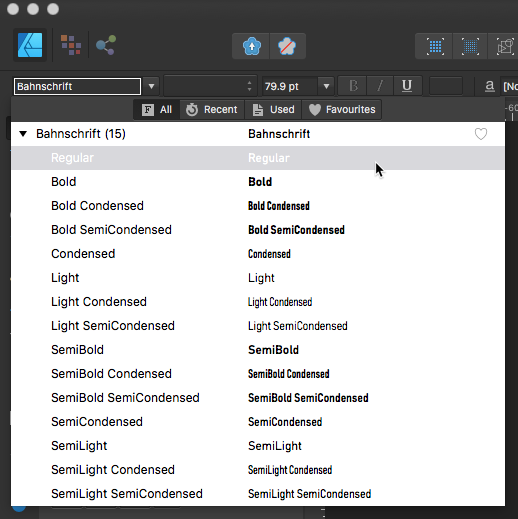Search the Community
Showing results for 'variable fonts'.
-
Variable fonts
Redesignerer replied to DarkClown's topic in Feedback for Affinity Publisher V1 on Desktop
I'm trying to switch to Affinity in my work, at some of the big creative agencies, but no support for variable fonts is a deal-breaker. Also, no apparent desire to consider it means it is hard to persuade others to give Affinity a go. I'm using variable fonts more and more often, and I am now getting locked back in to Adobe as Affinity just pretend they don't exist. -
@LibreTraining, @walt.farrell Thanks for clarifying. I didn't know the GF fonts offered a choice between installing static and variable fonts. I don't recall being given a choice as to which to install, but I wasn't looking for one either. At any rate, I can reinstall the fonts as static and have them work in AD.
-
The other good news from this article is that V2 is coming out this year, that is... if things go as planned. It would be nice if at least DXF import/export would be available when V2 comes out. Especially for those in the field of technical illustration (e.g. manuals) or need to export for cutting machines this would be really great to finally have this functionality. For those who need DWG support as well, the ODA has a free batch converter for Windows/Mac/Linux that can convert DWG files into DWF in batch or when you don't have DWG based software at all. That way you can still import into Affinity until DWG import/export is also implemented. Add support for variable fonts as well and I can finally do without CorelDRAW for most technical graphics. 🙂
- 401 replies
-
If you mean any of the GF variable fonts, yes, they will not work in Affinity apps. The GF static fonts work just fine. Note, the GF variable fonts are designed to have the same instance names as the static fonts. This is so if the user has either installed locally they will be used (saving the font download). Because of this it is not a good idea the have both the statics and variables installed. This will definitely cause conflicts in Affinity apps, and perhaps other applications too. This name conflict is why font designers generally use a different name on the variable version. GF does this on purpose as their goal is speed and to save the bandwidth.
-
Variable fonts are not supported i.e you can use the font under it's style such as bold condensed but you cannot change the weight of that style. Affinity also does not support Colour fonts, they will display as a single colour which can be a bit of a mess when the colours define the shape of the font.
-
Missing Fonts
Woodpig replied to Woodpig's topic in Pre-V2 Archive of Affinity on Desktop Questions (macOS and Windows)
Yes, it's a variable font problem. I've removed them and replaced with static fonts, and now it works fine. Thank you! -
Missing Fonts
Woodpig replied to Woodpig's topic in Pre-V2 Archive of Affinity on Desktop Questions (macOS and Windows)
Thanks, Hens. The PDF has been generated on my own computer, so uses the same OS. I think the software I'm exporting from may possibly use variable fonts. But I should still be able to substitute for static fonts, shouldn't I? I believe I have these installed for the font family in question. -
First: Here in 2022 right clicking on the style name under "text style" allows not only for editing the style, but has a lot of options for using paragraph style without over-writing your character styles. Second: Big thank you to Cylon Raven! It really never occurred to me to just cut and paste from my original document into Affinity. With other DTP software I would import and then apply styles. If I imported something like rtf or old *doc files it would at least still contain my tabs and if I was lucky, the subscripts and symbol fonts for variable names. With Affinity, I was disappointed that I could only import plain text. I'm not going to import pdf -for various reasons that's a hot mess for me. Importing plain text wouldn't be such a pain if the import text menu (Affinity calls it something else -place?) used the feature that strips out extra carriage returns so the text will wrap correctly. That problem was solved long ago, not sure where Affinity hides the feature to do that. I was about to start using text like [tab] when creating in my word processor, so at least I wouldn't have to manually retype all the tabs (this for numbered lists, and for aligning expressions to the "=" when defining variables in a list. I figured a global search and replace could replace the [tab] with the non-printing tab character. then my styles setting would handle the tab length, and whether its a left, tab, right or center tab. Then I realized I was taking the first steps to creating my own Tex language, or min-HTML and decide to check here to see what others are doing. Cut and past will be tedious for all the pages I'm doing, but not 1/10 as tedious as all the insertion of tabs, getting rid of carriage returns, redoing symbols, etc. Third: I am still trying to figure out what "optical alignment" means. I've seen it in the menus but it makes me wonder what alignments are not optical? I would expect options like vertical alignment, horizontal alignment, top alignment, bottom alignment, align center, . . . This sounds like some sort of display adjustment. Like aligning the photon guns on a CRT monitor. (Cathode Ray Tube -for younger readers who don't recall saner times.)
- 6 replies
-
- affinity publisher
- preserve text
-
(and 1 more)
Tagged with:
-
The MacOS font manager displays fonts which are not supported. That is not "correct." Per the OpenType specs when variable fonts are not supported the default master is to be used. So that is what is displayed on Windows - the only font which can actually be used. Listing a bunch of fonts which cannot be used is confusing to users as evidenced by the multiple posts from Mac users about both variable fonts and color fonts.
-
I already got them from above, and could convert them, but they are rather limited even after conversion. You may want to try a free open source alternative - Bodoni from indestructible type. The GitHub version has 7 optical sizes, 4 weights, with italics, small caps, tabular figures, oldstyle figures, stylistic sets, and other OpenType features - and about double the number of characters. Download the v2.3 release here: https://github.com/indestructible-type/Bodoni That ZIP includes OTF, TTF, and variable versions. Only install one of the static versions (TTF or OTF) for Affinity apps. Demo page here: https://indestructibletype.com/Bodoni.html Google Fonts has a different version of the same fonts. Bodoni Moda - https://fonts.google.com/specimen/Bodoni+Moda If those do not meet your needs, I can send you the conversions later.
-
Are you kidding? It is 2022 already and NONE of the Affinity products have implemented a telepathic remote control for the speed of the fans inside of microwave ovens... SERIOUSLY? For you it is multi-page spreads. For some it is right-to-left language support, or footnotes and endnotes, or cross-references, or the ability to make editable PDFs or various eBook formats, vector mesh warp, support for variable/color fonts, or more highly compressed raster export formats for use on web sites... First off, these are feature REQUESTS - we are asking for them - that does not mean that Serif is under any obligation to implement any of them, ever. Serif has been gradually implementing things that people are asking for, but they do need to prioritize and they may not always even agree with some of what people are asking for. Some features simply take time to implement and they can't do it all at once. There were comments in other threads already that they have tried to bring more developers on board to help speed some of these things up but that they have a hard time finding qualified people where they are located.
-

Variable fonts
MarekGFX replied to DarkClown's topic in Feedback for Affinity Publisher V1 on Desktop
Even though we should stick to the original thread and I do not agree with creating the duplicate, variable fonts mess is kinda weird and annoying. Adapting the concept of variable fonts is one thing but treating them like users does not have them installed or they do not exist is another -
Are you using 10.xx version of MacOS? Those are the overlaps used in variable masters (the source files) and required in the variable fonts for them to interpolate properly. When static fonts are created from a variable source, the overlaps may or may not be removed (it is not required). So some static fonts may still have overlaps. MacOS 10.xx does not handle the overlaps correctly. So the GF position is Apple needs to fix it (which they did in 11+). I am assuming you got the single static font from Cufon which is v1.001 and has no overlaps. Note: AFAIK .otf vs. .ttf does not matter in the case. But I do know for sure - it may be possible that MacOS can properly figure-out the PS curves. Dunno. We can test .otf PS fonts if you want. If you are not using MacOS, please provide more info.
-

Variable Fonts
jamessouttar replied to LLB's topic in Feedback for the Affinity V2 Suite of Products
Figma now has support for RTL fonts (for Arabic, Persian, Urdu, Hebrew etc.) and has supported variable fonts — through a plug-in — for some time already. Over the last few years I’ve been a big Affinity fan, and supporter, but Affinity is slipping behind when it comes to typography (there are still some rough edges with font support, especially for those with lots of alternatives and contextual features). Type is central to what most of us use Affinity applications for (especially Publisher) and I’d like to see their type handling be ahead of the curve, rather than perpetually languishing behind it. -
Hello, as the title says, Publisher 1.10.4 will crash every time I try to open my file. Using Mojave as OS. I tried all possible solutions found in the forum and nothing works: copied the file, moved to another folder, updated Publisher to 10.5, uninstall, reinstall to 10.4, reset PRAM, open the file with Affinity Photo and nothing. I sent a copy to a friend and her Windows version showed an error saying the file has characteristics from an older version of Publisher that can't be read so I'm staying with the 10.4 version for now. Attached the corrupted file and a copy of the error report, plus the installed fonts I'm using, mentioning preflight warns for missing the fine variable no matter how many times I reinstall the font family. Thank you for your attention. Tesis 05.afpub reporte01.rtf Alegreya_Sans.zip
- 6 replies
-
- affinity publisher
- publisher
-
(and 2 more)
Tagged with:
-

Corrupt Text PDF by Affinity Publisher PDF export
MikeW replied to albertkinng's topic in V1 Bugs found on macOS
You can also try clicking the More button and Not subsetting the fonts. Also, make sure you are not using the variable version of that font but instead only have the distinct styles installed. -
It's been more than 2 years people are requesting support for variable fonts. I'd like to bring this topic up since it seems not getting any attention. Of course this affects all Affinity products and not only Affinity Publisher. And if basic font support does not make it to the essential feature requirements please make sure to handle this failure/bug with a bit of dignity (even Photoshop 6 disables the styles for variable fonts and does not display random nonsense) Cheers, Timo
-
Welcome back to the Serif Affinity Forums, @notMateo. It sounds as though you may be trying to use variable fonts. Such fonts are not currently supported by the Affinity apps, so you’ll need to get hold of the corresponding static fonts if you don’t already have them. (Many Google Fonts, for example, are now available for download as variable fonts, but they come with a ‘static’ folder in the zip archive.)
-
Some other users have reported similar results. I think it is because of the Mac being able to display the SBIX font, but the APub and/or the PDF library not supporting it. The Mac font picker will display SBIX fonts, SVG fonts, variable fonts, etc. but they are not supported in APub (which confuses users). But can you print it or Export-to-PDF? If you can, that is more confusing. Why is the .notdef box appearing sometimes? There have been multiple posts regarding the LiebeHeide SBIX font not working in APub. So I have assumed SBIX is simply not working. If you are interested, I can send you the font to test (view, print, export to PDF, PNG, etc). I would certainly like to know (and others too) and have no way to test SBIX fonts. Also have Scrapbook Custom which is also SBIX/OTF. There is also an SBIX version of the free Bungee fonts (which I will attach below). Like to get Mac user test results on that font too if anyone wants to test. Yes, but I am not sure exactly what that means - "most emoji" It would be nice to know exactly which emoji fonts work on which platform. On Windows the default emoji font is Segoe UI Emoji, which is a COLR color font. And we can see from tests that other COLR color fonts also work (but not 100%). On the Mac the default emoji font is Apple Color Emoji, which is an SBIX color font. So what I would like to know is ... are other SBIX fonts also working? From the other posts about the LiebeHeide SBIX font it appears it is not working. LiebeHeide is also an OTF/SBIX not a TTF/SBIX (like Apple Color Emoji), and it also has an SVG back-up in it - so are those structural differences an issue? Or has something changed with some update and it works now? Bungee Color fonts for testing The free Bungee Color fonts include COLR, SBIX, and SVG versions in TTF format. You can get the originals from GitHub: https://github.com/djrrb/Bungee/releases/tag/1.1.0 I have renamed them so you can install all three at the same time (name conflicts in originals). BungeeColor.renamed.zip
- 32 replies
-
- font
- 100% black
-
(and 2 more)
Tagged with:
-

Typographic failure
DWright replied to dezwo's topic in Pre-V2 Archive of Affinity on Desktop Questions (macOS and Windows)
This font is a variable base one and we currently do not support these types of fonts, this feature has been requested but I do not know when this will be added to the apps.









